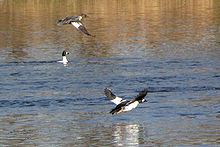- Common Goldeneye
-
Common Goldeneye 
Adult drake (Bucephala clangula americana) 
Adult female Conservation status Scientific classification Kingdom: Animalia Phylum: Chordata Class: Aves Order: Anseriformes Family: Anatidae Subfamily: Merginae Genus: Bucephala Species: B. clangula Binomial name Bucephala clangula
(Linnaeus, 1758)Subspecies - B. c. clangula (Linnaeus, 1758)
(Eurasian Goldeneye)
- B. c. americana (Bonaparte, 1838)
(American Goldeneye)
Synonyms Clangula clangula
The Common Goldeneye (Bucephala clangula) is a medium-sized sea duck of the genus Bucephala, the goldeneyes. Their closest relative is the similar Barrow's Goldeneye.
Adult males ranges from 45–52 cm (18–21 inches) and from 888 to 1400 grams (1.9 to 3.1 lbs), while females range from 40–50 cm (16–20 inches) and from 500 to 1182 grams (1.1 to 2.6 lbs). The species is aptly named for its golden-yellow eye. Adult males have a dark head with a greenish gloss and a circular white patch below the eye, a dark back and a white neck and belly. Adult females have a brown head and a mostly grey body. Their legs and feet are orange-yellow.
Their breeding habitat is the taiga. They are found in the lakes and rivers of boreal forests across Canada and the northern United States, Scandinavia and northern Russia. They are migratory and most winter in protected coastal waters or open inland waters at more temperate latitudes. Naturally, they nest in cavities in large trees. They will readily use nestboxes, and this has enabled a healthy breeding population to establish in Scotland where they are increasing and slowly spreading with the help of nestboxes. They are usually quite common in winter around lakes of Britain and some are being encouraged to nest in nestboxes which are put up to try to have them there all year round.
Often the natural tree cavities are made by broken limbs, unless they are made by Pileated Woodpeckers or Black Woodpeckers, the only tree-cavity-making animals who make a cavity large enough to normally accommodate a goldeneye. Average egg size is a breadth of 43.3 mm (1.7 inches), a length of 59.3 mm (2.3 inches) and a weight of 64 grams (2.3 oz). The incubation period ranges from 28 to 32 days. The female does all the incubating and is abandoned by the male about 1 to 2 weeks into incubation. The young remain in the nest for about 24–36 hours. Brood parasitism is quite common both with other Common Goldeneyes as well as other duck species and even Tree Swallow and European Starling eggs have been found mixed with goldeneye eggs! The broods commonly start to mix with other females' broods as they become more independent. Goldeneye young have been known to be competitively killed by other goldeneye mothers, Common Loons and Red-necked Grebes. The young are capable of flight at 55–65 days of age.
These diving birds forage underwater. Year-round, about 32% of their prey is crustaceans, 28% is aquatic insects and 10% is molluscs. Insects are the predominant prey while nesting and crustaceans are the predominant prey during migration and winter. Locally, fish eggs and aquatic plants can be important foods. They themselves may fall prey to various hawks, owls and eagles, while females and their broods have been preyed upon by bears (Ursus spp.), various weasels (Mustela spp.), mink (Mustela vison), raccoons (Procyon lotor) and even Northern Flickers (Colaptes auratus) and red squirrels (Tamiasciurus husonicus).
The Common Goldeneye is one of the species to which the Agreement on the Conservation of African-Eurasian Migratory Waterbirds (AEWA) applies.
Approximately 188 300 Common Goldeneyes were killed by duck hunters in North America during the 1970s, representing about 4% of the total number of ducks killed in the region during that period[citation needed]. The rate is probably similar today. Both the breeding and winter habitat of these birds has been degraded by clearance and pollution. However, this is the only duck in North America known to derive short-term benefits from lake acidification.
References
- ^ BirdLife International (2009). "Bucephala clangula". IUCN Red List of Threatened Species. Version 3.1. International Union for Conservation of Nature. http://www.iucnredlist.org/apps/redlist/details/141562. Retrieved 25 August 2011.
External links
- Common Goldeneye videos, photos & sounds on the Internet Bird Collection
- Cornell Lab of Ornithology: Common Goldeneye
- USGS Patuxent Bird Identification InfoCenter: Common Goldeneye
- photograph of adult
- photograph of courtship display
- South Dakota Birds and Birding: Common Goldeneye Information and Photos
- eNature.com: Common Goldeneye
- Common Goldeneye wildlife photos and voice
Categories:- IUCN Red List least concern species
- Bucephala
- Birds of Pakistan
- Birds of Europe
- Birds of Iran
- Birds of Turkey
- British Isles coastal fauna
- Animals described in 1758
Wikimedia Foundation. 2010.



